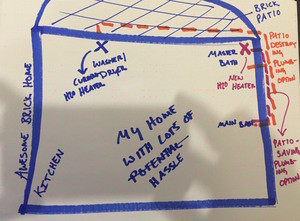A water heater. Seems like a simple purchase, no? A boring purchase, even. Who knew it was possible that so much drama could surround such a benign item?
One of the best parts of our new house is that it is fully reinforced brick. Incredibly energy-efficient and such an awesome feature in an era when homes are typically built with cheap framing and sheet rock.

Awesome, that is, until we learned that we’ll need to re-plumb our entire house. To do that, we will have run our plumbing along the exterior of the home (catch your breath northerners, it’s Arizona – my pipes won’t burst). Because our water heater is on one side of the house, we’ll need to run pipe along the entire exterior of your patio and tear up all of the hard-scaping. Or, we can choose to buy a second water heater to service that side of the house.
Finding the path of least destruction.
Our contracted plumber (who is fantastic and efficient) recommended a standard efficiency hot water heater to my amazing husband Eric. Who, knowing what I would say to that, asked about an energy efficient model. The efficient, German-engineered electric tankless model, he said, was going to cost us $2500 (!).
Since I was traveling while all of this was going down, and dealing with the plumbing is step one on a critical path to a timely remodel, Eric panicked at the cost of the energy efficient model and ordered the standard efficiency model. Scratch that off the list.
Option 1: Fancy German Model that I didn’t bother to research. – NO
Then we talked.
Hold the phone!!! I said. There’s NO WAY a water heater should cost us $2500 to heat just two bathrooms!
So, in my stubborn and somewhat controlling way, I set about to find a tankless or efficient hot water heater. I was going to purchase it myself and hand it to the plumber to install.
Easy-peasy, right? Wrong.
First, I searched online. Navigating the ENERGY STAR website was painful, onerous time-consuming – I have aftercare enrollment forms to fill out! Not to mention, I could not find any qualifying models that I could buy off the shelf at the local Home Depot or Lowes either while I was painstakingly cross-referencing Energy Star against local websites. Then I realized ENERGY STAR only certifies electric heat pump hot water heaters (as far as I can tell).
So, I searched for Heat Pump Hot Water Heaters, because our client NEEA is sponsoring them in the Northwest and I thought I should give it a go. Why not support their efforts to transform the market down here in the Southwest? Then I saw the price. Out of the box and without a rebate, I was looking at a cash outlay of $1500-2000. For an unanticipated hot water heater purchase as the first cost in a large remodel, this was far outside of the budget and scary to take on. For that price, I could redo the entire patio….
Option 2. Heat Pump Water Heater – NOPE
As the clocked ticked, I considered purchasing a solar hot water heater. But to receive a rebate for that, I would need to have a gas hook-up to qualify. How much would it cost me to route a gas line? Just an additional $500… I seriously considered it. But then I thought, if I am considering using solar for the whole home at some point, I would need to retain the electric hook-ups.
Option 3. Solar Hot Water Heater – NOT GOING TO HAPPEN
At this point I was tired, irritated, and needed an easy fix. I went to Home Depot and they had a single tankless electric hot water heater. It was not Energy Star qualified. But I could not wait any longer. So I reluctantly crossed this option off my list, and purchased this guy:
Did I make the right decision? I’ll have to report back.
Option 4. Anything ENERGY STAR Certified – I CAN’T BELIEVE ITS COME TO THIS
Now, I just hope the single tankless option can deliver on its promises. It makes me very nervous, but I could not trade-off delays in our remodel (e.g. keeping my family in our tiny rental home any longer) to seek out the perfect hot water heater. So here we are, again, with an uncomfortable and less expensive compromise. On to the kitchen remodel….






